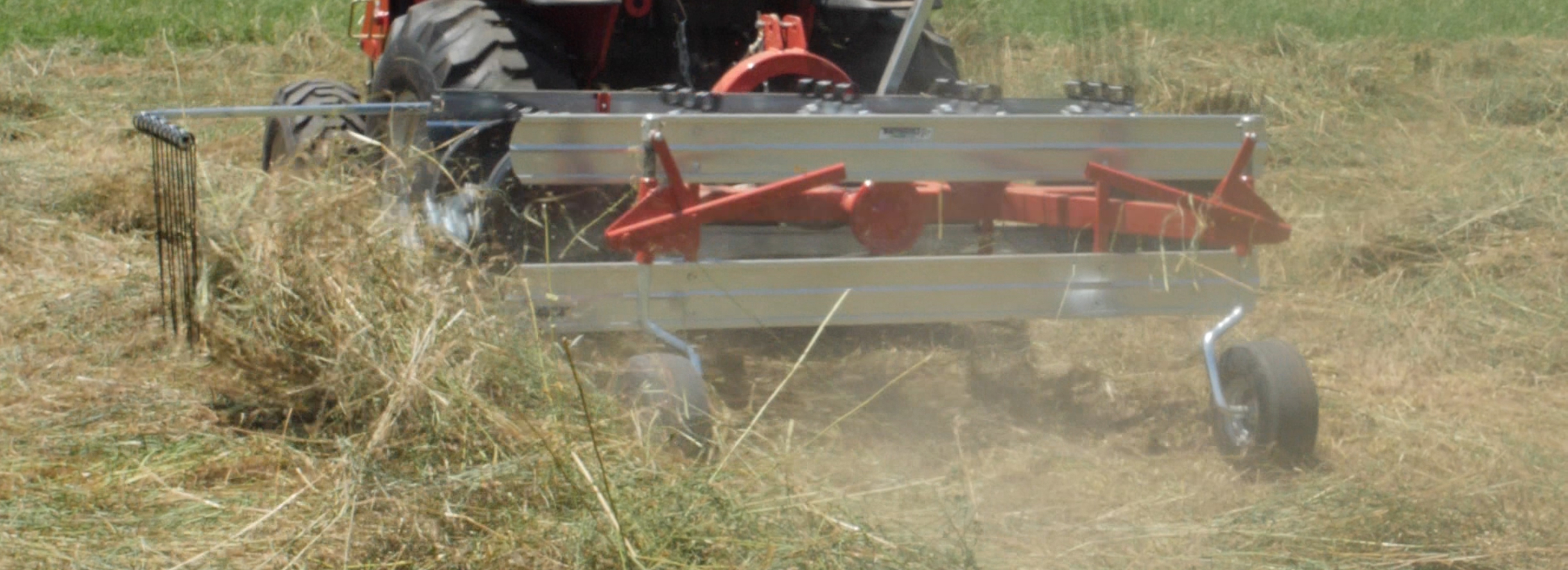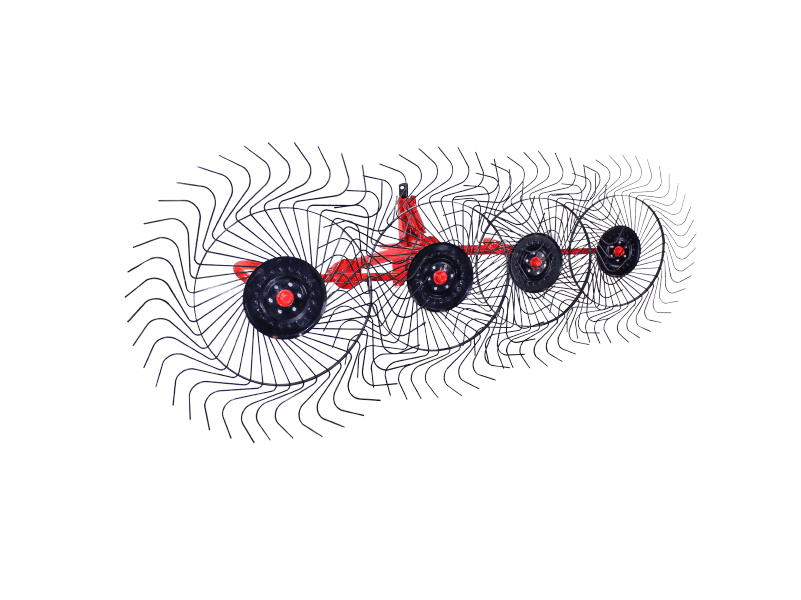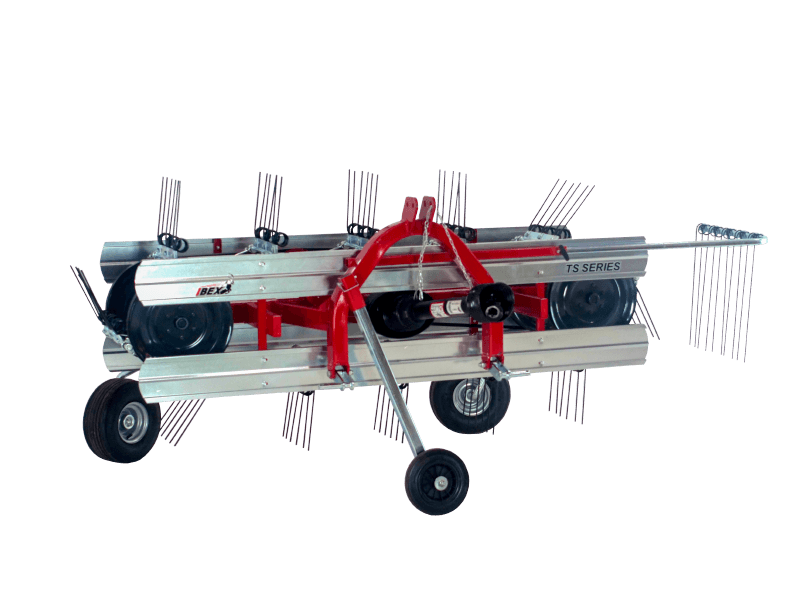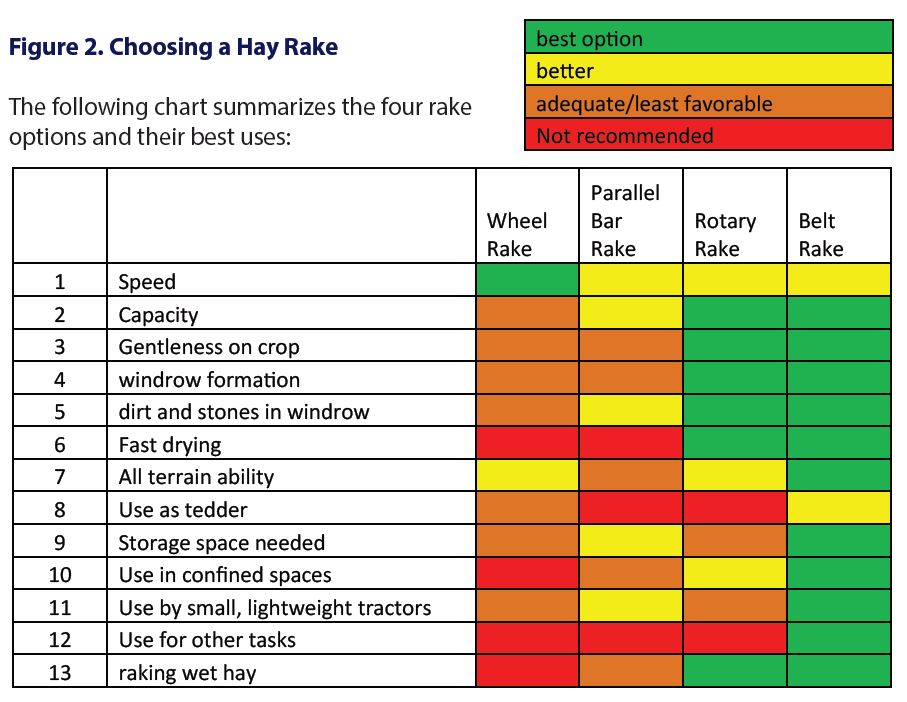Small Farm Hay Production: Choosing a Hay Rake

Choosing a hay rake for your small-farm operation can seem like a daunting task. The choices for hay rakes are many. Different regions of the country seem to prefer different styles of rakes. In this blog we will break down their similarities and differences so that you can make the most sensible investment for your hay production needs.
What is a Hay Rake?
A hay rake rakes hay into windrows which are lines of hay that can be more easily picked up by a baler. It is a common misconception that hay can be baled directly from the swath created by the hay mower. There are a few reasons why this will not generally work. First, in most climates, hay will not dry well unless fluffed, flipped, or turned by a tedder and/or rake. Second, the path left by the hay mower will generally not be conducive to pick up by a baler, resulting in a lot of missed hay. Third, you can normally rake at least two mower swaths into one windrow for baling, resulting in fewer passes across the field with the baler and better quality, more consistently dense bales.
"The four most prominent styles of hay rakes are wheel rakes, parallel bar (rollabar) rakes, rotary rakes, and belt rakes. Let’s look at each of these."
Wheel Rakes

These rakes are built for speed and productivity when handling dry hay. Wheel rakes are simple machines that require minimal adjustments for proper operation. The economical ground drive simplifies operation and reduces cost. However, its direct contact with the ground can cause dirt and stones to be introduced into the hay, decreasing overall quality.
The windrow created by a wheel rake will not be as light and fluffy as those produced by rotary rakes or belt rakes. This means that only minimal drying will occur once the hay has been raked. Also, using a 3-point mounted wheel rake takes some practice, especially if your field has a lot of curves or corners. Wheel rakes are physically large, so they take up a lot of space when stored. Even with these drawbacks, wheel rakes are very popular due to their low cost of purchase and maintenance.
Parallel Bar Rakes
Called by many different names in different regions of the US, these machines are relatively simple, with a design that dates back over 100 years. Rotary rakes and belt rakes are similarly priced and have additional benefits, such as the ability to produce fluffy windrows in all crop conditions. Wheel rakes are a more economical choice and offer similar raking quality to parallel bar rakes.
Presently the parallel bar rake is being replaced by other rake designs. Though many of these old rakes are still in use throughout the US, if you are considering a new rake purchase, another design will likely suit your needs better and provide you with more versatility.
Rotary Rakes
These powered rakes create a uniform and fluffy windrow, which allows crops to dry faster. The gentle rotary-raking action minimizes leaf loss and provides a more uniform windrow for better bale formation. These rakes are capable of handling both wet forage and dry hay, giving them a greater versatility than wheel rakes. A rotary rake’s mechanical drive enables it to move heavy, wet crops. It also keeps the tines from contacting the ground, minimizing the amount of contamination raked into the crop. This results in higher-quality feed.
Rotary rakes come in a wide variety of sizes for just about any size of tractor. These machines are easily maneuverable and closely follow changing field contours for clean raking. They also can be either 3-point mounted or trailed, allowing them to be used by most tractors with a PTO.
Belt Rakes

Belt rakes, also called power rakes, have all the advantages of a rotary rake. They can handle both wet and dry forage; they make a fluffy, consistent windrow; the tines do not touch the ground, reducing contamination of the forage; and they come in a wide variety of sizes.
Belt rakes, however, have several advantages over rotary rakes. For the same raking width, belt rakes are much more compact in size, making them much easier to use and store. Their compactness and lighter weight also make them easier for your tractor to lift, making transport and navigation of rough terrain simpler. They are available in a wider range of working widths making them ideal for working in tight spaces like orchards and pine plantations.
The versatility of a belt rake cannot be matched by any other type of rake. A belt rake is 2 machines in 1—a rake and a tedder. Going from rake to tedder is as easy as removing the hay stop and making a wheel adjustment, requiring only a few seconds and no tools. Lowering the rake with a simple adjustment of the wheels allows the tines to aggressively contact the ground, which is great for dethatching lawns or preparing a seedbed for planting.
The belt rake is also the easiest of the rake types to use. Because it is so compact and operates directly behind the tractor, the operator spends less time turned around checking to see where his rake actually is. And because it is powered by the tractor PTO, it continues to run while stationary, or when backing up, allowing you to use the rake in reverse in tight spaces. It also does a better job around corners and will not pile up hay like a wheel rake when turning. Thus, you will end up with a straighter, fluffier, more consistent windrow that dries better and is easier to follow with a baler.
Choosing a Hay Rake
The following table summarizes the four rake styles and their best uses.

Hopefully this break down of the different rake styles will help you to make the best choice for your hay operation. If you’d like more information on rakes or other small farm hay equipment, please check out our website here or give us a call at 1-260-BALE-HAY today!
Recent Posts
-
How to Winterize Your Tractor: Essential Maintenance Tips to Protect Your Investment
Farm equipment is one of the most valuable investments a farmer can make. At Tractor Tools Direc …Dec 1st 2025 -
Farm Tax ID Explained: Benefits, Eligibility, and How to Apply
As the end of the financial year approaches, it's a great time for small farmer operators to rev …Nov 12th 2025 -
Rototillers vs. Power Harrows: Which Tool is Best for Your Soil?
Fall might seem like an odd time to talk about planting, but there really is no better time to t …Oct 27th 2025




